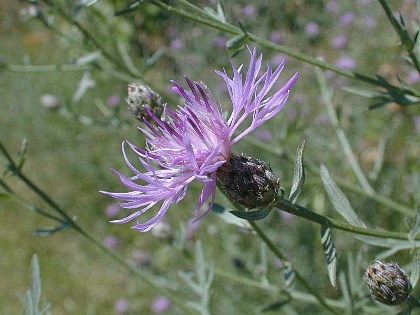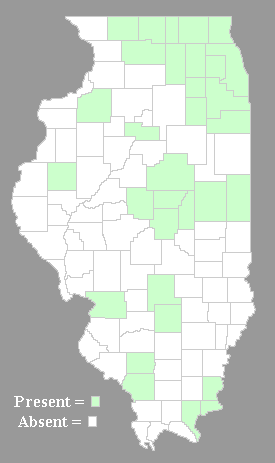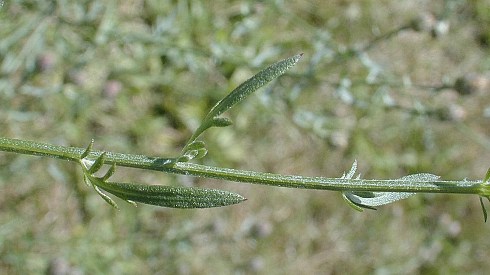Description: This plant is a short-lived perennial about 2-3' tall. It branches occasionally to frequently, becoming broader toward the flowering stems. The stems are ribbed and pubescent with a stiff woody texture. The alternate leaves are up to 3½" long and 1½" across; they are sparsely distributed along the stems. They are pubescent and pinnately lobed; these lobes are narrow, and the terminal lobe of each leaf is usually the longest. If the basal leaves haven't withered away, they are somewhat larger than the cauline leaves and deeply pinnatifid. Both the stems and the foliage are whitish or greyish green, although the base of the central stem often turns brown with age.

The upper stems
terminate in flowerheads about ¾" across. Each flowerhead consists of
numerous ray florets that are pink to purplish pink, overlapping floral
bracts that are greyish green, and no disk florets. Each floral bract
is ovate, tapering to a black tip with coarse short bristles that are
dull white to brownish black; there are several dark green veins toward
the base of each bract. These bracts are appressed together. The ray
florets are slender, thread-like, and branching; the outer florets are
the longest and sterile. The blooming period occurs from mid-summer to
early fall and lasts about 1-2 months. Each floret is replaced by an
oblong achene that has a crown of short bristles on top; these bristles
may fall off. The root system consists of a taproot. It often forms
colonies at favorable sites, and spreads by reseeding itself. The
achenes are spread to a limited extent by the wind.
 Cultivation:
The preference is full sun, mesic to dry conditions, and a poor soil
that contains gravel or clay; alkaline soil is tolerated quite well.
Both the foliage and roots of this species exude a powerful toxin that
can destroy the root systems of other plants. This is one of the
reasons it often forms colonies.
Cultivation:
The preference is full sun, mesic to dry conditions, and a poor soil
that contains gravel or clay; alkaline soil is tolerated quite well.
Both the foliage and roots of this species exude a powerful toxin that
can destroy the root systems of other plants. This is one of the
reasons it often forms colonies.
Range & Habitat:
The non-native Spotted Knapweed is common in NE and east-central
Illinois, and
occasional to absent elsewhere within the state. Official records
undoubtedly underestimate the distribution of this plant; it is
probably still spreading. Habitats include gravelly areas along
roadsides and railroads, dry waste areas and eroding slopes, pastures
and abandoned fields, and vacant lots in cities. This plant occurs in
disturbed areas primarily; sometimes it is found along the edges of
prairie remnants near railroads. In some of the Western states, Spotted
Knapweed has become a serious weed, but it is less of a problem in
Illinois. This species is adventive from Eastern Europe and the
Ukraine, and first appeared in the United States and Canada during the
1890's.
Faunal Associations:
The nectar of the flowers attracts various long-tongued bees,
butterflies, and skippers. Various insects from abroad have been
introduced to control this species (and other Knapweeds), including Cyphocleonus
achates (Knapweed Root Weevil), Agapeta zoegana
(Yellow-Winged Knapweed Moth), Sphenoptera jugoslavica
(Yugoslavian Root Beetle), and two Urophora spp.
(Seedhead Flies). It is possible that some granivorous birds and small
rodents eat the seeds to a limited extent. Mammalian herbivores
normally shun this plant because of the bitter foliage; but they will
eat it if little else is available, as occasionally occurs in
overgrazed pastures. Some of the seeds of Spotted Knapweed can pass
through the digestive tracts of livestock and remain viable; thus,
these animals may help to distribute the seeds. People also help to
spread Spotted Knapweed by means of their motor vehicles (the seedheads
can become caught on the under-carriage) and through the transportation
of baled hay or contaminated seed stock.
Photographic Location:
At the edge of a lawn near Lake Kaufmann Park in Champaign Illinois;
this site was located only a short distance away from a railroad.

Comments: The attractive flowerheads resemble those of the much cultivated Centaurea cyanea (Bachelor's Buttons). The slender leaves of this latter species, however, are not pinnately lobed. There are other Centaurea spp. (Knapweeds), but they are more common in the drier Western states. Some of these have yellow flowerheads with a thistle-like appearance, while others have flowerheads that are similar to Spotted Knapweed. The appearance of the floral bracts is critical in making a species identification. The floral bracts of Spotted Knapweed have a tick-like appearance with black tips and coarse bristles that resemble the legs of this invertebrate; these bracts are appressed together, rather than spreading. Other knapweeds have floral bracts that lack black tips or bristles, or their bracts may be spreading rather than appressed together, or their bracts may have sharp spines. Other scientific names for Spotted Knapweed are Centaurea maculosa and Centaurea stoebe micranthos.